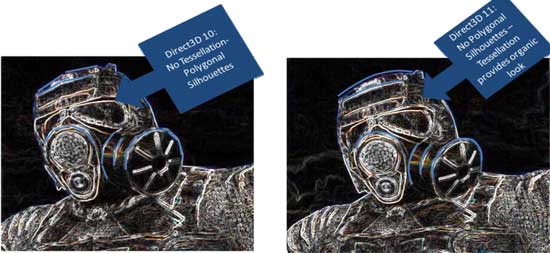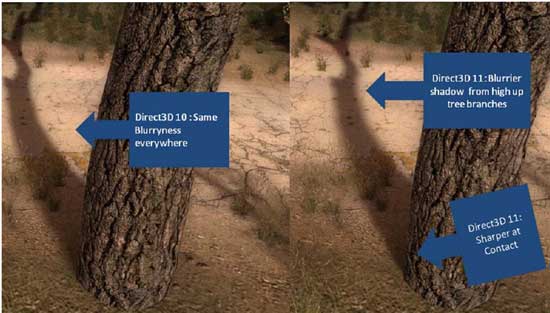The Radeon HD 5970: Completing AMD's Takeover of the High End GPU Market
by Ryan Smith on November 18, 2009 12:00 AM EST- Posted in
- GPUs
STALKER: Call of Pripyat – A Peak at More DX11
For the 5970 launch, AMD sent over a special benchmark version of STALKER: Call of Pripyat, which has since then been made public at the GSC Game World STALKER website. STALKER is another one of AMD’s big DX11 titles, as it’s technically the 2nd DX11 title to launch and the first such title to implement most of the major DX11 features. The Russian version actually shipped back in October, and the German version shipped 2 weeks ago. However we’re told that these versions only had an early-stage implementation of the DX11 feature set, and that the demo is more representative of where the game is after patching and what it will be like when it finally launches in the rest of the world early next year.
Since it’s an unplayable demo, we’re going to forgo any competitive benchmarking (it’s not as if anyone else has a DX11 card anyhow) but we will look quickly at the performance impact of these features, since this is the closest thing we have to a playable game using them at this point in time.
STALKER makes use of 3 major DX11 features.
- High Definition Ambient Occlusion using compute shaders
- Tessellation
- Contact hardening shadows
We’ve already seen HDAO with Battleforge, and it’s no different here in STALKER. And we’ve covered tessellation in-depth in our look at DirectX 11.
So today, let’s talk about contact hardening shadows. Shadowing has been on a path of particularly noticeable evolution. The first real shadows, seen in such titles as Doom 3, had very hard edges. Stencil buffering was used to determine where a shadow would fall, and that was it. Diffusion was never taken into account. Newer games have since taken diffusion into account to generate soft shadows, but these shadows aren’t necessarily accurate. Currently soft shadows are implemented with a fixed degree of softness around the entire shadow, which isn’t how shadows really work.
With diffusion, the softness of a shadow increases with the distance of the casting object from the surface the shadow is being displayed on. AMD loves to use a light pole as an example, as the top of the shadow should be softer than the bottom. These shadows are referred to as contact hardening shadows, and the use of them in games has been limited by the expense of calculating them using the DX10 feature set. STALKER allows for contact hardening shadows with DX10.1 and DX11 mode.
Unfortunately a moving benchmark makes for a poor source to take screenshots, so we’re going to stick with AMD’s reference shots here. Only contact hardening shadows are particularly noticeable in the benchmark; tessellation and HDAO are there, but are virtually impossible to catch given the zoomed-out nature of the benchmark and the fact that it’s constantly in motion.
The benchmark comes with 4 different flybys, each under different environmental conditions: day, night, day with rain, and day with sun shafts. We’ve gone ahead and benchmarked the game during the “day” flyby, once with the DX11 feature set enabled, and once with it disabled. This means for DX11 mode tessellation, contact hardening shadows, and Ultra HDAO were enabled; and for DX10 tessellation and contact hardening shadows were disabled, and High HDAO was used.
| STALKER: Call of Pripyat, Day Benchmark | DX10 | DX11 |
| Average FPS | 31.4 | 35.1 |
| Minimum FPS | 17.7 | 21.2 |
Enabling all of these features actually causes performance to rise, thanks to the more efficient implementation of HDAO as a compute shader as opposed to a pixel shader. Ultimately what this means is that unless HDAO is disabled entirely, STALKER is going to be faster on a DX11 card running the entire DX11 feature set than it will be when running the DX10 feature set.
The biggest performance hit, and the reason we’re not breaking 40fps here even with a 5970, is due to how anti-aliasing is implemented in STALKER. As it uses deferred rendering, the game does its own anti-aliasing. We used 4X MSAA here along with per-pixel alpha transparency testing (basically Adaptive/Transparancy AA). Disabling anti-aliasing improves performance dramatically.













114 Comments
View All Comments
Lennie - Wednesday, November 18, 2009 - link
If so, then one could suspect it's the same issue with games due to VRMs of this particular card getting heated up and throttling the card. Perhaps not enough contact between VRM and HSF or a complete lack of TIM on VRM by accident. I would have reseated the HSF if I owned that card.Rajinder Gill - Wednesday, November 18, 2009 - link
I suspect it is VRM/heat related. The 'biggest' slaves Volterra currently supply are rated at 45 amps each afaik. Assuming ATI used the 45 amp slaves (which they must have), you've got around 135 amps on tap. Do the math for OCP or any related throttling effects kicking in. Essentially, 1.10VGPU puts you at 150w per GPU before things either shut down or need to be throttled (depends on how it's implemented as it nears peak). Any which way you look at it, ATI have used a high end VRM solution, but 4 slaves per GPU would have given a bit more leeway on some cards. I wonder what the variance is in terms of leakage from card to card as well. Seeing as there's not much current overhead in the VRM (or at least there does not appear to be), a small change in leakage would be enough to stop some cards from doing too much in terms of overclocking on the stock cooler.later
Raja
Silverforce11 - Wednesday, November 18, 2009 - link
It could be your PSU, some "single rail" PSU arent in fact using a single rail but several rails with a max limit on AMPs. Its deceptive.Guru3D uses 1200W PSU and manages 900 core, which is typically what a 5870 OC to on air. Essentially the chips are higher quality cypress, maybe you should retry it again with a different PSU then conclusions can be drawn.
Bolas - Wednesday, November 18, 2009 - link
Yep, there is certainly a market for 5970CF. Can't wait!tajmahal - Wednesday, November 18, 2009 - link
Big deal, another paper launch where only a tiny handful of people will be able to get one.LedHed - Tuesday, November 24, 2009 - link
My question is why do the OC the 5970 but not the 295...We all know the 295 is memory bottlenecked at resolutions at/over 2560x1600
But considering the GTX 295 is down below $450 and no one can find these cards in stock with a god awful price of $600 ($100 more than 295 at launch).
mschira - Wednesday, November 18, 2009 - link
newegg list 5 different models, they come and go quite fast.I managed to get one of them in my shopping card.
All it would need now is pay. (which I don't want to...).
So yea they are not exactly easy to get, but far from impossible.
So not a paper launch.
Be real, it's day two after the launch, and you CAN get them. That's not bad at all.
M.
MrPickins - Wednesday, November 18, 2009 - link
At the moment, Newegg shows two different 5970's in stock. A HIS and a Powercolor.tajmahal - Wednesday, November 18, 2009 - link
Listed, but not available. I guess newegg sold both of the ones they had available, and the 5850 and 5870 ?......... not available either.Silverforce11 - Wednesday, November 18, 2009 - link
Plenty of 5870s around at retails and etailers, what do you mean by "another paper launch"?